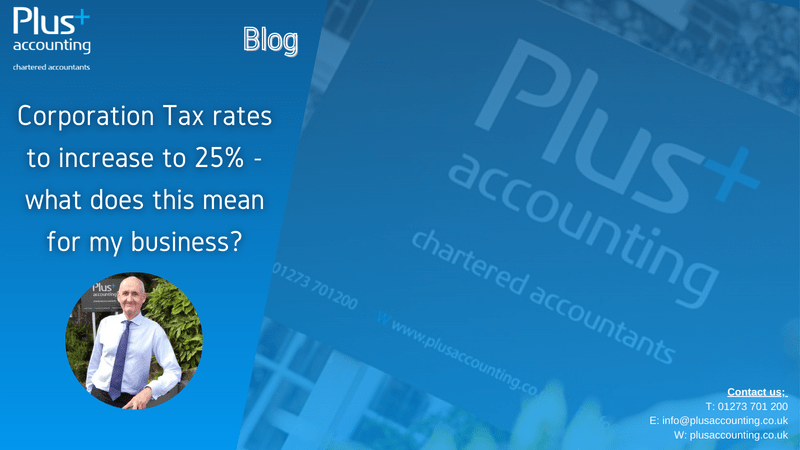
INCREASE IN CORPORATION TAX RATES 2023
One of the main money earners for the Exchequer which was announced in the Spring Budget was the increase in the rate of corporation tax for companies for periods after 1 April 2023, which headlined as an increase in the rate from 19% to 25% for profits over £250k per annum. For many corporates, this may appear to be irrelevant on the face of it (how many SMEs are into the £250k plus profit range?) but there are many issues under the surface which need consideration before the new regime begins in 2023.
Marginal rate of tax
Many (slightly) longer in the tooth business people will recall the days before 2014 when we last had a dual rate of corporation tax, and we are now rewinding to that regime from 2023. As a reminder to those people, and an introduction for those new to the game or who were not affected by the rules before 2014, one of the main features of the system is that the rate does not change on a “cliff edge” at the £250k profit figure, but gradually moves towards 25% between £50k and £250k. This means that between those two figures, the rate of tax applicable to each ££ of additional profit has to be taxed at a rate higher than 25% in order that the overall rate applicable to profits of £250k is 25%. For those (like me) who are not too mathematically-minded, an example may help with this concept:
| Tax payable on £50k profit (at 19%) | £9.5k |
| Tax payable on £250k (at 25%) | £62.5K |
| Tax payable on profits between £50k and £250k | £62.5k – £9.5k = £53k |
| Rate of tax on £200k profit between £50k and £250k | £53k/£200k = 26.5% |
This means that every ££ of profit earned between £50k and £250k is taxed at 26.5% – a higher rate than profits over £250k!
As I mentioned above – this was a feature of the tax system before 2014, but the applicable limits were £300k (instead of £50k) and £1.5m (instead of £250k) – a fine example of reverse inflation! Clearly this means that a much larger number of businesses will be faced by this issue than previously.
Associated companies
And that is not all……….the Government is aware that “unscrupulous” company owners and their advisers will look at these limits and decide to set up additional companies to run different aspects of their businesses so that they can enjoy multiple £50k limits at a tax rate of 19%. There is therefore a rule which says that the £50k and £250k limits have to be divided between all companies which are (generally) under common control. Whilst the motive for this rule is clear, it unfortunately cannot distinguish between multiple companies set up to exploit these limits and groups of companies established for genuine commercial reasons. There are many entrepreneurs who have split different aspects of their business between different companies in order to “ring-fence” risks or to enable different shareholding arrangements, or many other reasons – they will all be affected by this rule. You might think that this does not make any difference as you will still have £50k/£250k to divide between your companies but it is not that straightforward – the limits are divided by the number of “associated” companies, and each company receives only that amount. For instance, if you have an active holding company and two trading companies, each company will only have £16,667 profit at 19%, and pay 25% on profits over £83,333, so they will have to ensure that each company makes at least £16,667 in order to take full advantage of the lower tax rate.
Profit planning
A prominent feature of the system pre-2014 which will be revived post 2023 is that company owners will want to keep profits out of the marginal tax rate (26.5%) band by keeping them under £50k. Under the previous regime a lot fewer businesses were involved in this planning as the marginal rate did not come in until £300k profits were reached, but clearly a very large proportion of incorporated businesses these days earn profits in excess of £50k and will need to consider this. In its basic form this will involve director/shareholders using salary and pension contributions (which are a deduction from a company’s taxable profit) for their drawings, as opposed to dividends, which are not deductible from profit. Pensions cannot be backdated and there are difficulties in relating salary back to a previous period, so this will ideally involve “in year” planning based on reliable interim accounting figures and forecasts.
Incorporation of businesses
The new higher rates of corporation tax have not been matched by increases in the rates applied to sole traders and partnerships, who pay income tax on their profits. In addition, the income tax rates applied to dividends taken from companies’ post tax profits have not been reduced to compensate for the increase in the tax payable by the companies on those profits. This will therefore swing the calculation of the overall tax burden away from incorporation for those whose profits are over £50k, particularly if they wish to draw more than about £50k from their company. For those that have already incorporated to take advantage of the current rates, the possibility of moving back to sole trade will occur to them, but there are tax charges on “disincorporation”, and this action would need to be carefully considered. There are also many other issues to bear in mind which are of benefit to corporates, such as
- limited liability
- ability to manage personal tax liabilities, including maximising CGT Business Assets Disposal Relief (formerly Entrepreneurs Relief)
- availability of R&D relief and Creative Industry Tax Reliefs such as Video Games Tax Relief
- ability to raise funds more readily through tax-approved schemes like EIS and SEIS
- ability to incentivise staff through tax-favoured share schemes
Capital allowances “super-deduction”
The decision by the Government to increase the corporation tax rate significantly from April 2023 has indirectly lead to an apparently very generous hike in the amount of tax relief available on capital expenditure. This is because someone at HMRC realised that companies would be inclined to delay capital expenditure until after April 2023 to maximise the tax relief on that expenditure, with unfortunate knock-on effects for the economy. How to prevent this? – increase the amount of pre-April 2023 capital expenditure on which tax relief can be claimed by 30% to match the approximately 30% increase in the tax deduction available from April 2023 – simple! From 1 April 2021 until 31 March 2023, tax relief will be available for 130% of capital expenditure, with no limit on the qualifying amount. The assets acquired have to be new, and will be “pooled” separately from non-qualifying expenditure so that any sale proceeds received for them in future will also be increased by 30% for tax purposes, which raises the nasty prospect of 130% of proceeds received after 31 March 2023 being taxed at 25% or 26.5%, what is known as a “double-whammy”! This demonstrates that care needs to be taken over claiming this relief where assets which hold some value are involved.
A lot to think about for limited company SMEs in the next 18 months or so – it will be here before we know it!
Author: Peter Hedgethorne, Director, Plus Accounting
Any views or opinions represented in this blog are personal, belong solely to the blog owner and do not represent those of Plus Accounting. All content provided on this blog is for informational purposes only. The owner of this blog makes no representations as to the accuracy or completeness of any information on this site or found by following any link on this site.
Date Published: 18 August 2021



